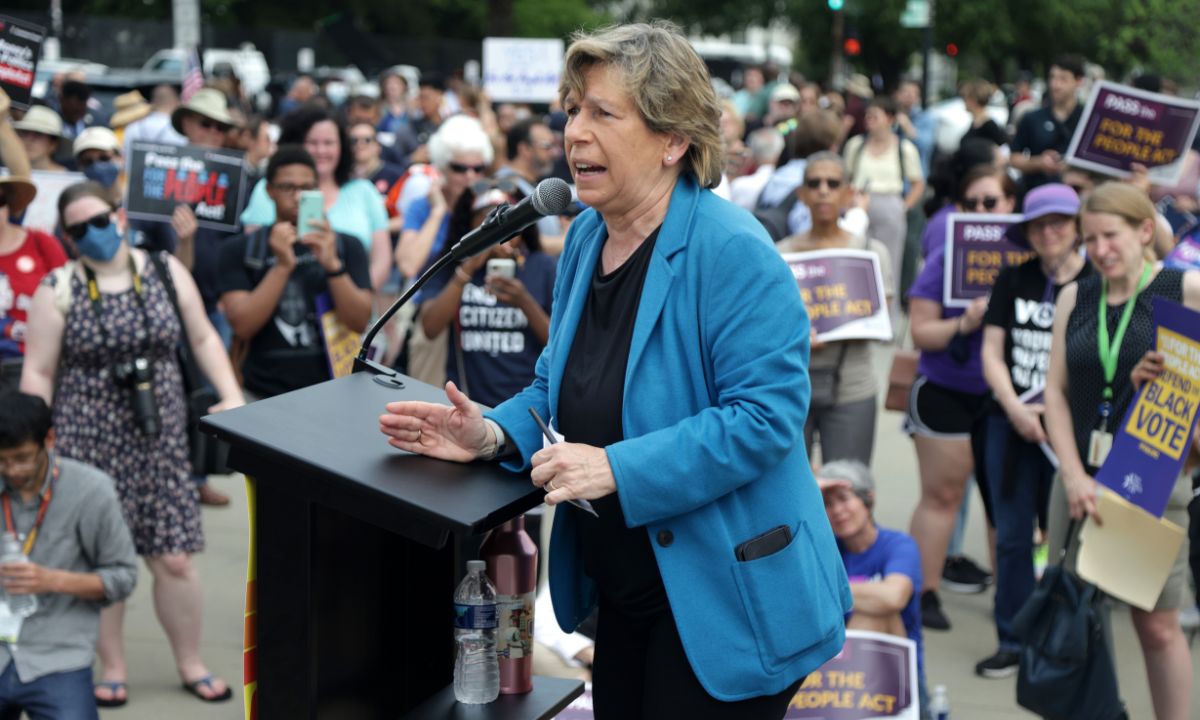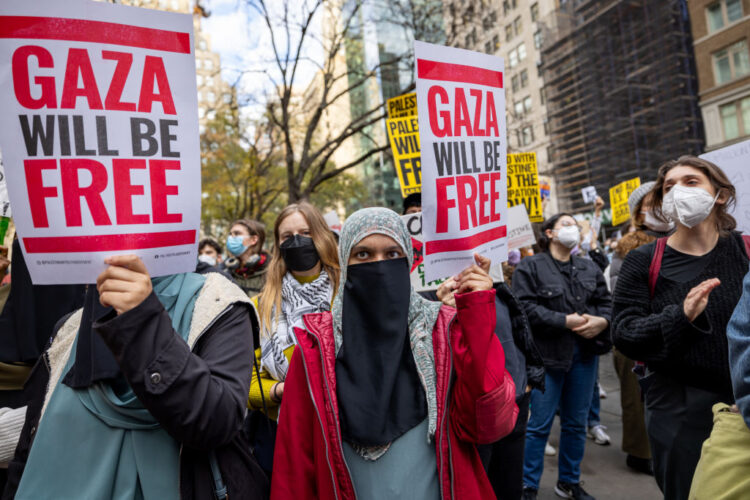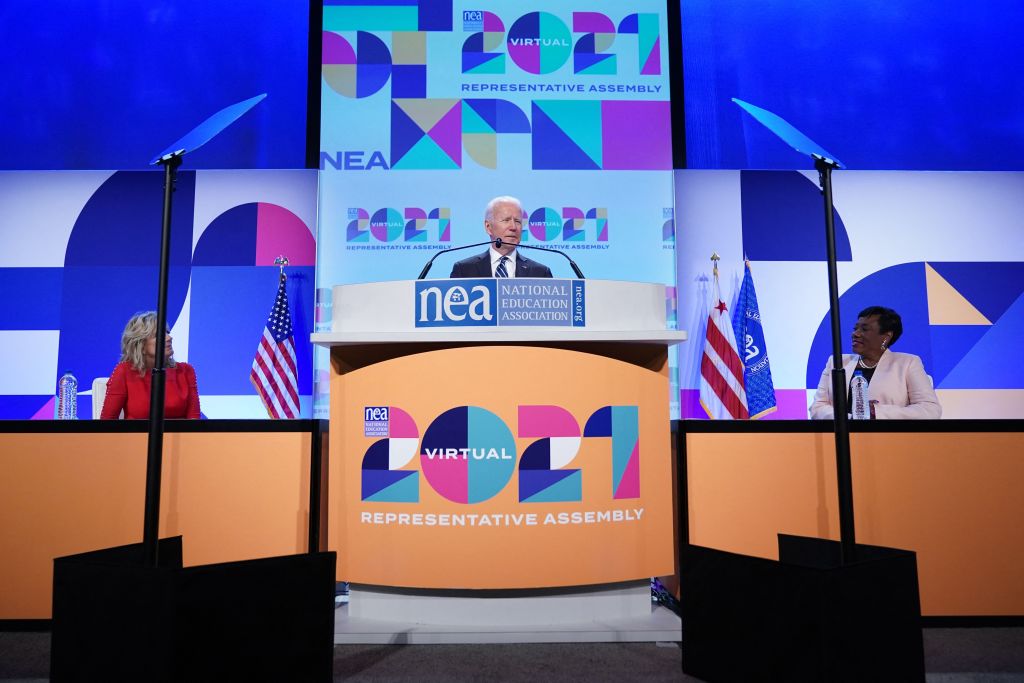Teachers’ Unions are Calling for Ceasefire in Gaza. What Does it Tell Us About November?
The unions’ willingness to wade into foreign policy might cause heartburn in the White House.

Get stories like this delivered straight to your inbox. Sign up for The 74 Newsletter
When the American Federation of Teachers, America’s second-largest teachers’ union, officially called for a cessation of hostilities in Gaza on January 30, its language was clear, but careful.
The resolution listed the conditions necessary for a bilateral ceasefire, including the release of Israeli hostages and the provision of more humanitarian aid. It excoriated Hamas, both for its Oct. 7 terrorist assault and the brutal repression suffered by Gazans under its control, as well as the Netanyahu government for obstructing the possibility of a two-state solution. Further criticism was reserved for antisemitism, Islamophobia and the attempted censorship of dissenting views.
The document was notable for its timing as well as its substance. By the end of January, a growing number of union affiliates and leaders had already made similar pronouncements, though often voiced in much harsher terms.
Becky Pringle, speaking for the National Education Association’s three million members, demanded a permanent truce on Twitter on December 8 — a position that was later reaffirmed by the organization’s board of directors. In mid-November, the United Educators of San Francisco said Israel’s military campaign violated the United Nations Universal Declaration on Human Rights, but made no mention of the Oct. 7 attacks or the captivity of over 200 hostages. And in early December, a pro-Palestinian “teach-in” was organized by Oakland Education Association members who developed special lesson plans in defiance of the local school board.
In an interview with The 74, AFT president Randi Weingarten said her union’s process moved more slowly in order to build support. Study groups were held to gather the views of internal constituencies, including the organization’s Jewish Heritage Committee. Partly in order to gain the unanimous backing of its 43-member executive council, she acknowledged, drafting the resolution “took some time.”
“Early on, it was hard to have a real conversation…because it was so fractured,” Weingarten said.
Four months after the events of Oct. 7, significant political fractures still cleave the labor movement, both within organizations and between unions and their allies in the Democratic Party. Several of the resolutions have been rejected by members as hurtful, or even anti-Semitic, and while President Biden is now attempting to move both parties toward a six-week ceasefire, he has not publicly broken with Israeli Prime Minister Benjamin Netanyahu or significantly altered his administration’s stance on the effort to capture or kill Hamas’s leaders. The division threatens to influence the outcome of the 2024 elections, with a faction of NEA members working to rescind the union’s endorsement of Biden against Donald Trump.
Those dissenters will almost certainly fail, and Israel’s armed incursion may culminate long before November. But while the war is unlikely to directly unseat Biden, it is a reflection of fissures on the left that very well might. Public opinion research suggests that many Americans favor a ceasefire, but also that Democrats are much more divided than Republicans on whether the U.S. should continue to support its closest ally in the Middle East. That divide is both a product of long-term political trends and a potent short-term threat.
Michael Hartney, a political science professor at Boston College and fellow at Stanford University’s conservative Hoover Institution, said that the decision to take a stance on something as controversial as the Gaza war illustrated how the currents of polarization could determine the course of even formidable political actors: Though distant from the day-to-day priorities of nonprofit and activist groups, hot-button issues like Israel have become central to the political identity of many members and have gradually become boxes that such organizations must check.
“I think it’s due to the changing landscapes of the incentives facing these interest groups,” Hartney said. “For them to fundraise and be influential, they basically have to pick a team.”
Rise in pro-Palestinian sentiment
Teachers unions, and particularly the AFT, have previously been involved in organizing and advocacy in the Middle East. Just two days before Hamas attacked Israel in October, Weingarten — a Jew who has made multiple trips to Israel during her nearly 16-year tenure as the Federation’s president — joined the board of J Street, a liberal nonprofit that lobbies politicians on American-Israeli relations and security priorities. Her counterpart, the NEA’s Pringle, also took a three-day tour of schools in Israel and the Palestinian territories last year.
But the posture of some groups within the labor movement has shifted in recent years as criticisms of Netanyahu’s leadership and Israel’s occupation of the West Bank have grown louder on the left. In 2021, following an outburst of violence in East Jerusalem that left hundreds dead, the United Educators of San Francisco became America’s first teachers’ union to pass a resolution supporting the “boycott, divest, and sanction” [BDS] movement, a contentious project intended to isolate Israel. United Teachers Los Angeles, representing 30,000 school employees in America’s second-largest district, debated a similar measure before ultimately tabling it.
At the same time, perceptions of Israel have become more divided in U.S. politics overall. In public opinion surveys long predating the violence of the last few months, younger Americans have been much more likely to directly blame Israel for its periodic clashes with Hamas, and people between the ages of 18 and 29 said they were more sympathetic to Palestinians than Israelis in the wake of Oct. 7.
Jack Jennings, a former longtime Democratic staffer in the U.S. House, said the emerging generation gap was largely explained by the country’s changing demographics, which have seen a pronounced uptick in the number of students of Middle Eastern origin. Both Jewish and Muslim Americans have tended to vote Democratic in recent elections, but the mounting salience of Israeli-Palestinian conflict had generated tension that was being felt “first in the classroom,” Jennings said.
“What has caused this change, and caused the local unions to adopt these resolutions, is that the number of Muslims in the country has doubled” between 1990 and 2020, Jennings said. “When the teacher opens her door on Monday morning, she may have five Palestinians in there.”

Weingarten has generally attempted to chart a middle course in the public debate, lambasting Netanyahu’s conservative government while also opposing BDS resolutions and describing herself as a “progressive Zionist.” The AFT resolution appeared to reflect that nuance, leaving out the invocations of Israeli “genocide” or “settler colonial violence” seen in the rhetoric of some other teachers’ unions.
David Dorn, who headed the AFT’s International Affairs division for decades before retiring 10 years ago, applauded the resolution as one of the best he had seen from an advocacy group. During his time with the union, he remembered, he had found the work of drafting such documents “hard and boring.”
“They mean nothing. It’s a piece of paper that is usually forgotten 24 hours later,” Dorn lamented. “But that was a good resolution, and maybe she can have the union play a good role under the circumstances.”
Dorn represents a tradition of international activism within the labor movement that helped shape geopolitics throughout the 20th century, but isn’t well remembered today.
Under the leadership of Albert Shanker, who led the AFT from 1974 to 1997, the union energetically worked to bolster democratic movements and labor rights throughout the world. Its maneuverings were sometimes controversial, as when the stridently anticommunist Shanker and his allies opposed Nicaragua’s far-left Sandinista government in the 1980s. But even decades later, the AFT still touts its work to strengthen the Solidarity movement in Poland and challenge apartheid rule in South Africa.
The fall of Soviet Communism — along with the passing from the scene of Shanker and other internationally minded figures at the AFL-CIO — led to a decline in unions’ outreach overseas, Dorn said. Weingarten “wasn’t really steeped in that tradition” to the extent of her predecessors, he added, and many organizational leaders are now more focused on sustaining their membership at home.

“Going to conferences or making statements is one thing, but I don’t see many unions using their own resources and grants” to effect change abroad, Dorn said. “It’s too bad, but life goes on, and the Cold War is over.”
While acknowledging that the AFT has been “more limited” in the range of its international involvement over the last few years, Weingarten said the union still played a robust role promoting issues of democracy and self-determination on the world stage. After Weingarten made a 2022 visit to Ukraine, for example, the Federation purchased a fleet of generators and partnered with a Polish teachers’ union to deliver them to schools affected by Russia’s attacks on the country’s power grid.
“Other unions have really ratcheted down, but we’ve always had an international department,” Weingarten said.
Post-Janus realignment
What the spate of ceasefire resolutions will accomplish — and what they signify for a labor movement that has attained more prominence in recent years even as it has shrunk within American workplaces — remains to be seen.
Some teachers’ union members and advocates have wondered why, at a time when schools are faced with expiring COVID relief funds and students experience profound learning challenges, their designated bargaining representatives are staking their credibility on a conflict unfolding thousands of miles away. Others are distressed that their organizations haven’t gone farther to demonstrate opposition to Israel’s actions.
William Galston, a veteran scholar at the Brookings Institution who has previously advised Democratic presidential candidates, observed that unions weren’t the only political players to comment outside of their traditional areas of interest. With the members of America’s ideological camps increasingly converging toward shared preferences — such that the AFT, the Sierra Club, and Planned Parenthood share many of the same donors and preferred candidates on the left, while NRA and Americans for Prosperity do so on the right — groups that previously organized around a relatively narrow slate of issues are under more pressure to demonstrate their adherence to a party line.
“They used to be more narrowly focused on occupational issues, but for purposes of coalition maintenance, unions and other activist organizations are called upon to take positions on a very wide range of issues,” Galston said.
The Hoover Institution’s Hartney offered an additional theory. In the aftermath of the Supreme Court’s decision in Janus v. AFSCME, the case that forbade public sector unions from extracting fees from non-members, those organizations were left with a choice: quiet their political activities to attract more potential members, or tie themselves closer to Democratic politics to further engage their most enthusiastic organizers. While potentially polarizing, he said, the second course might be more workable in the short run.
“It’s possible that they’re doubling down on appealing to their true believers by making them feel extra valued,” Hartney said. “Maybe they can get double the PAC donations from true believers to offset the fact that they’ll get zero support from the marginal person who can leave post-Janus.”

Even so, there is a risk of significant downside in any position that leaves daylight between national entities like AFT and the Biden White House, especially in an election year in which all segments of the Democratic coalition will be called on to help reelect the president. Polling continues to suggest that Biden’s stance on the war is leaving younger voters cold, and a union-led opposition to Israel’s operations in Gaza could highlight that faultline.
Weingarten said she was unconcerned about the possibility of a split between her union and the president, pointing to Biden’s and Secretary of State Antony Blinken’s furious efforts to broker a temporary ceasefire contingent on hostage releases. Notwithstanding the substantive differences between that policy and activists’ hope of a more lasting peace, she added, key officials are “very much involved in attempting to get to a ceasefire.”
“There’s a big difference between what the president of the United States can say publicly and what the president of the United States operationalizes privately.”
Get stories like these delivered straight to your inbox. Sign up for The 74 Newsletter

;)
